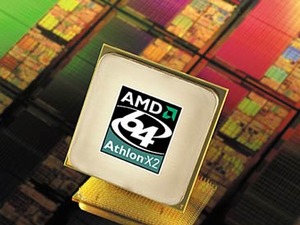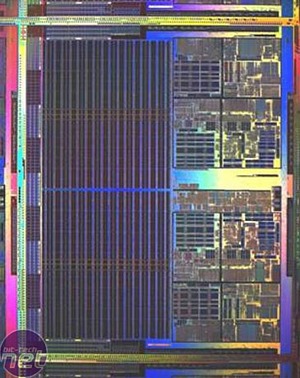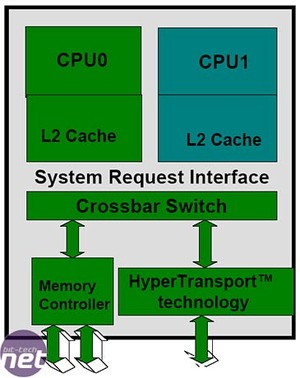The talk of doubling up has been going around for a while now. We’ve already seen NVIDIA pair up two video cards to gain more performance with SLI, and there are rumours that ATI’s multiple video card solution, MVP, will be launched at Computex at the start of next month. We will have to wait and see whether the rumours hold true, but everything is starting to double up in the quest for a smoother computing experience.
Intel’s dual core Pentium D was released over a month ago, but we are still awaiting products to get to retail. Intel seems to have fallen by the wayside with a paper launch that shows no sign of any products appearing on the virtual shelves of your favourite etailer any time soon. Having said that, today AMD are launching the Athlon 64 X2 processor on paper, as AMD have told us that the X2 processors will be available in June. So, all in all, the push towards dual core CPU’s is not quite up to speed just yet.
As soon as both solutions are available, we will let you know. Until then, let's get on with some dual core silky smooth goodness.

Why is two better than one?
Both Intel and AMD have based a lot of the hype of dual core around the improved multi-tasking performance and general smoothness of day-to-day usage in the desktop environment. After using a dual core processor for the first time this weekend, it really does make a difference to general use. No longer do you need to worry about whether you can watch a DVD while backing up your latest MP3’s to CD – I’ve used a HyperThreaded Pentium 4 for a while now and everyone has always mentioned how smooth things were with a second logical processor. I agree.
However, the addition of a second physical processor seems to make a lot more difference than I thought it would. We will come to look at how well it performs in due course, but it is hard to quantify just how smooth everything feels when you have a second core under the hood.
The internals

 The Athlon 64 X2 4800+ processor has 1MB L2 cache per core, meaning that there's a total of 2MB of L2 cache on the CPU. Whilst the cache is discrete, the cores use the same memory controller and HyperTransport link to the rest of the system, which is handled by the internal 'crossbar switch'.
The Athlon 64 X2 4800+ processor has 1MB L2 cache per core, meaning that there's a total of 2MB of L2 cache on the CPU. Whilst the cache is discrete, the cores use the same memory controller and HyperTransport link to the rest of the system, which is handled by the internal 'crossbar switch'.
The system request interface makes use of something that AMD term as a 'crossbar switch'. We've seen the introduction of a 'fragment crossbar' in to NVIDIA's NV4x GPU's, and AMD's crossbar switch operates in a similar way. It splits down and redirects the instructions to their destination in an efficient manner, allowing for greater efficiency in a multi-tasking environment. In many ways, the dual core Athlon 64 X2 could be compared to a simple SMP system. We say this because a typical SMP system would have two cores, each with an independent L2 cache, while they would share the same memory controller (typically located in the northbridge).
However, in saying that, the rest of the system will treat the CPU in more or less the same way as a single-core Athlon 64.
Intel’s dual core Pentium D was released over a month ago, but we are still awaiting products to get to retail. Intel seems to have fallen by the wayside with a paper launch that shows no sign of any products appearing on the virtual shelves of your favourite etailer any time soon. Having said that, today AMD are launching the Athlon 64 X2 processor on paper, as AMD have told us that the X2 processors will be available in June. So, all in all, the push towards dual core CPU’s is not quite up to speed just yet.
As soon as both solutions are available, we will let you know. Until then, let's get on with some dual core silky smooth goodness.

Why is two better than one?
Both Intel and AMD have based a lot of the hype of dual core around the improved multi-tasking performance and general smoothness of day-to-day usage in the desktop environment. After using a dual core processor for the first time this weekend, it really does make a difference to general use. No longer do you need to worry about whether you can watch a DVD while backing up your latest MP3’s to CD – I’ve used a HyperThreaded Pentium 4 for a while now and everyone has always mentioned how smooth things were with a second logical processor. I agree.
However, the addition of a second physical processor seems to make a lot more difference than I thought it would. We will come to look at how well it performs in due course, but it is hard to quantify just how smooth everything feels when you have a second core under the hood.
The internals


The system request interface makes use of something that AMD term as a 'crossbar switch'. We've seen the introduction of a 'fragment crossbar' in to NVIDIA's NV4x GPU's, and AMD's crossbar switch operates in a similar way. It splits down and redirects the instructions to their destination in an efficient manner, allowing for greater efficiency in a multi-tasking environment. In many ways, the dual core Athlon 64 X2 could be compared to a simple SMP system. We say this because a typical SMP system would have two cores, each with an independent L2 cache, while they would share the same memory controller (typically located in the northbridge).
However, in saying that, the rest of the system will treat the CPU in more or less the same way as a single-core Athlon 64.

MSI MPG Velox 100R Chassis Review
October 14 2021 | 15:04






Want to comment? Please log in.